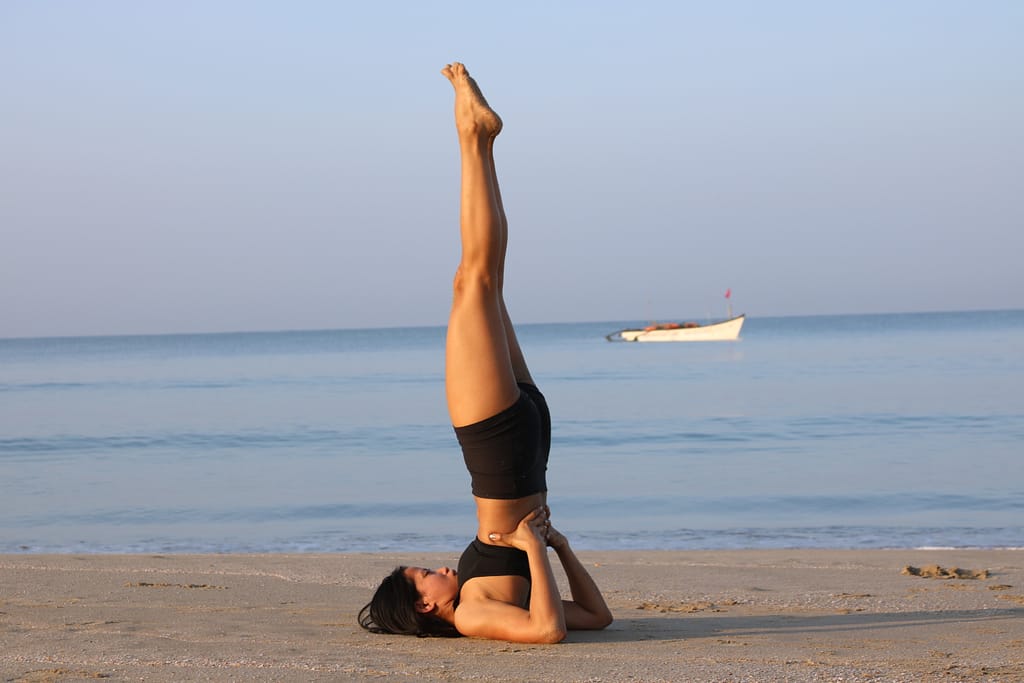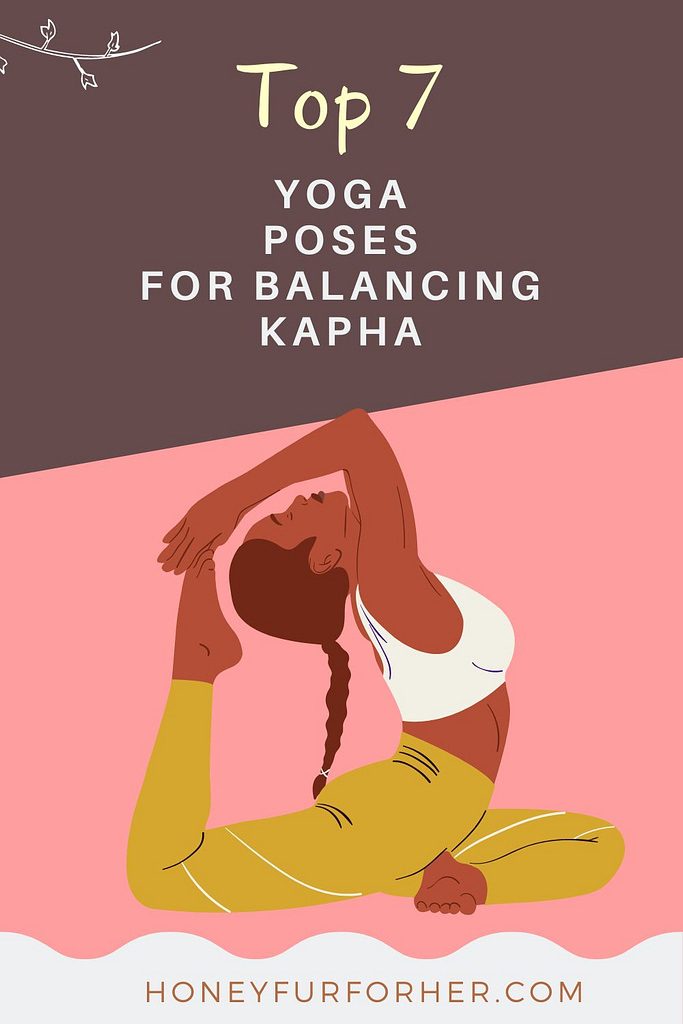Medical Reviewer: Dr Surabhi Rawat
Kapha Dosha is one of the primary tridoshas that make up the constitution of our body. I have previously written a detailed post describing what Kapha Dosha comprises so you can read it if you need more details. The seat of kapha dosha is the chest. Aggravated kapha is generally manifested in the chest area and causes illnesses related to it like chest congestion, bronchitis, asthma. Here are top 7 yoga poses that help reduce aggravated kapha by increasing the blood flow in the chest and stretching the pulmonary cavity.
1. Yoga Poses For Kapha Dosha – Surya Namaskar (Sun Salutation)
Surya Namaskar is not one yoga pose but a series of 12 yoga poses done in continuation. Out of them, 5 poses are repeated twice in reverse making it 12 in total. The origin of Surya Namaskar is Hatha Yoga itself although it not directly picked up from their rather it is a modern adaptation and is used as a warm-up exercise. It is considered excellent for developing aerobic stamina, increasing body strength and flexibility at the same time, something which all modern exercises lack. There are numerous other internal benefits like stress relief and also the development of inner peace and feeling of calm. Following is the list of poses done sequentially in Surya Namaskara
I. Pranamasana (The Prayer Pose)

II. Hastha Uttanasana (Raised Arms Pose)

III. Hastha Padaasana (Hand To Foot Pose)

IV. Ashwa Sanchalan Asana (Equestrian Pose)

V. Parvatasana (Downward Facing Dog)

VI. Asthanga Namanasana (Salute with eight parts)

VII. Bhujang Asana (Cobra Pose)

Rest of the 6 asanas are just the same as above performed in reverse.
VIII. Parvat Asana (Mountain Pose)
IX. Ashwa Sanchalan Asana (Equestrian Pose)
X. Hastha Padaasana (Hand To Foot Pose)
XI. Hastha Uttanasana (Raised Arms Pose)
XII. Tadasana (Standing Mountain Pose)
All 12 Asanas done together at a fast pace at least 10 to 12 times in a row daily is extremely beneficial. It looks like this

This is the basic version of Suryanamaskar. There are other variations like Surya Namaskar A and B found in Asthanga Yoga Series also which are equally beneficial and are considered a bit more challenging.
2. Halasana (Plow/Plough Pose)

Halasana is called so because hala in sanskrit means plough. In Halasana, your body’s shape resembles a plough. There are many benefits of practicing it in your daily routine. A few are mentioned below:
- It improves your back strength and flexibility.
- It also works great for increasing abdominal and leg strength and muscle tone.
- It is excellent for enhancing your sympathetic nervous system.
- It helps improve the digestive system and is also useful in asthma and bronchitis.
- It increases blood circulation and is also beneficial for regularising the blood glucose level of diabetic people.
- It is especially helpful for women going through menopause.
3. Yoga Poses For Kapha Dosha – Setu Bandha Sarvangasana (Bridge Pose)

Setubandha is derived from the word setu in Sanskrit which means a bridge. It is a great asana to do if you want to improve your back strength, however, if you suffering from severe back issues, you should skip this asana. Also, it puts pressure on your neck so if you have neck issues, I suggest you skip it. Here are a few benefits of practising Setubandha Sarvangasana
- Reduces stress, anxiety, fatigue, insomnia, and mild depression. Since in this pose, the heart is placed above the head it gives you all the benefits of an inversion.
- It normalizes blood pressure and increases blood circulation in the body.
- It stimulates the thyroid gland and regulates metabolism.
- Strengthens the back muscles as well as legs and buttocks.
- Improves digestion by reigniting the digestive fire.
- Helps in PMS pains and menopause symptoms.
- Opens up the lungs and chest making the muscles stronger. Kapha dosha is dominant in these areas so the regular practice of Bridge pose reduces effects of asthma and bronchitis and overall quality of breath improves.
4. Salamba Sarvangasana (Shoulder Stand Pose)

Shoulder Stand or Salamba Sarvangasana is also considered a semi-inversion pose. It is considered a bit difficult to master, so it is advised that it is done in the presence of a yoga instructor. Here are some of the benefits of practising a shoulder stand
- Increases the blood flow to the upper body, which helps in improving brain function. It alleviates depression and anxiety and makes the practitioner feel calmer and relaxed.
- Stretches the shoulder and neck muscles giving them strength and flexibility.
- Makes legs and abdominal muscles stronger and toned.
- Improves the digestive system and liver function.
- Stimulates the thyroid and prostate glands.
- Helps in reducing symptoms of asthma, bronchitis, and sinus.
5. Yoga Poses For Kapha Dosha – Salabhasana (Locust Pose)

Locust Pose or Salabhasana is a preparatory asana foback bendingng asana like Dhanurasana (Bow Pose). It is a comparatively easier pose and is excellent for lower back and legs. Here are a few benefits
- Strengthen the lower back, spinal muscles, buttocks, arms and legs. Extremely helpful in reducing lower back pain and spinal problems.
- Helps relieve stress and anxiety.
- Stretches legs, chest, belly and thighs. Helps improve posture.
- Increases concentration and stimulates the brain and abdominal organs.
It is advisable to do this asana with at least 6 hours of fasting and a clean bowl.
6. Yoga Poses For Kapha Dosha – Simhasana (Lion Pose)

The name Simhasana comes from Sanskrit word Simha which means Lion. In this pose, the face is formed in the form of a Lion’s roar. You might feel a bit conscious doing it in the beginning as the facial muscles are pulled and eyes are widened to look like a lion’s roaring face. Regular practice of Simhasana has the following benefits
- Makes your facial muscles firm, and it has an anti-ageing effect for the facial skin.
- Stimulates the vocal cords and opens up the throat. Helps in reducing speech-related issues as well. It is considered great for singers.
- Helps reduce thyroid and tonsil related problems.
- Helps improve back posture and gives relief in back pain.
- Helps in all ENT (Ear Nose Throat) problems.
There are a few different variations of this asana. Check out the following video which describes how to practice
7. Mayurasana (Peacock Pose)

Mayurasana is one of the hardest to perform but with regular practice, it becomes easier. It takes a lot of abdominal and upper body strength to perform. The best time to practice Mayurasana is in the morning on an empty stomach. Since you have to support your whole body on your hands and wrists, it best you skip it if you have a wrist injury.
There are numerous benefits of Mayurasana. Here are a few to take note of:
- It detoxifies the body. It releases toxins and also helps get rid of tumours.
- It improves back, abdominals, shoulders, arms and spinal strength.
- It improves blood circulation in the abdominal region which improves digestion, menstrual cycles for women. It stimulates the reproductive organs.
- It improves the posture of the back.
- It creates calmness and increases the concentration power of the mind as it needs a lot of control to practice. It helps reduce stress and anxiety.
Images courtesy: centroyogaarjuna.it , yogajournal.com, cocolett.com, naturehomeopathy.com
Did you find this post useful? Would you like to get back to it later? Save THIS PIN below to your Pinterest Natural Living or Yoga board!

